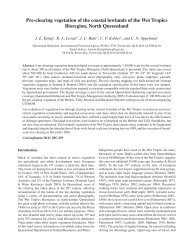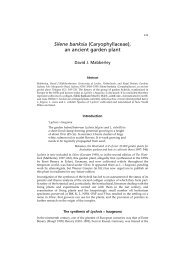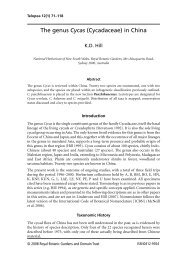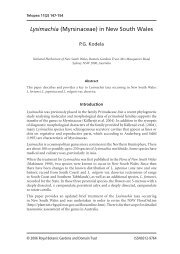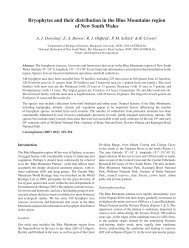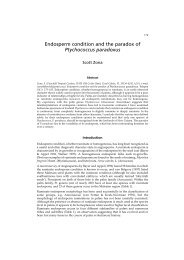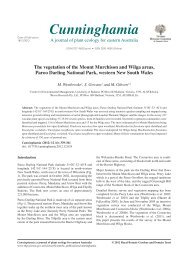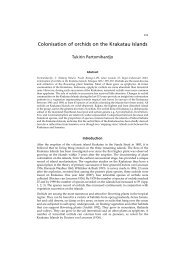The Eucalypts of the Greater Blue Mountains World Heritage Area ...
The Eucalypts of the Greater Blue Mountains World Heritage Area ...
The Eucalypts of the Greater Blue Mountains World Heritage Area ...
Create successful ePaper yourself
Turn your PDF publications into a flip-book with our unique Google optimized e-Paper software.
Cunninghamia 11(4): 2010 Hager & Benson, <strong>Eucalypts</strong> <strong>of</strong> <strong>the</strong> <strong>Greater</strong> <strong>Blue</strong> <strong>Mountains</strong> <strong>World</strong> <strong>Heritage</strong> <strong>Area</strong> 443<br />
able to make some generalisations about <strong>the</strong> habitat <strong>of</strong> many<br />
<strong>of</strong> <strong>the</strong> eucalypts, details <strong>of</strong> <strong>the</strong> ecology <strong>of</strong> most species are<br />
still poorly-known. How <strong>the</strong>y will respond to <strong>the</strong> changed<br />
conditions as temperatures increase, available moisture<br />
changes and fire patterns change is impossible to predict with<br />
our current knowledge. To guide management in conserving<br />
all <strong>the</strong>se species for future generations we definitely need<br />
more research on <strong>the</strong> ecology <strong>of</strong> <strong>the</strong>se dominants <strong>of</strong> <strong>the</strong><br />
Australian forests.<br />
Acknowledgements<br />
<strong>The</strong> vegetation surveys within <strong>the</strong> GBMWHA were funded<br />
by <strong>the</strong> Central Branch <strong>of</strong> <strong>the</strong> Parks & Wildlife Group<br />
within DECCW, and by <strong>the</strong> Sydney Catchment Authority.<br />
We would like to thank Daniel Connolly, Stephen Bell<br />
and Peter Myerscough for <strong>the</strong>ir advice and comments on<br />
<strong>the</strong> manuscript. We would also like to thank Bob Conroy<br />
for initially encouraging us to prepare <strong>the</strong> definitive list <strong>of</strong><br />
eucalypts, and for his support for <strong>the</strong> biodiversity survey<br />
program within <strong>the</strong> GBMWHA. Thanks are also due to <strong>the</strong><br />
botanists who have undertaken <strong>the</strong> (<strong>of</strong>ten arduous) field<br />
surveys.<br />
References<br />
Bell S.A.J. (1998) Wollemi National Park Vegetation Survey. A fire<br />
management document. (East Coast Flora Survey Warners Bay<br />
NSW).<br />
Bell, S.A.J. (2001) Notes on <strong>the</strong> distribution and conservation status<br />
<strong>of</strong> some restricted plant species from sandstone environments<br />
<strong>of</strong> <strong>the</strong> upper Hunter Valley, New South Wales Cunninghamia<br />
7 (1): 77–88.<br />
Bell, S.A.J. (2008) Rare or threatened vascular plant species <strong>of</strong><br />
Wollemi National Park central eastern New South Wales<br />
Cunninghamia 10 (3): 331–371.<br />
Bell, S.A.J., Klaphake, V., & Nicolle, D. (in prep) Eucalyptus<br />
expressa (Myrtaceae): a distinctive new species from <strong>the</strong><br />
sandstone ranges north-west <strong>of</strong> Sydney, New South Wales. MS<br />
submitted to Telopea (2010).<br />
Benson, D.H. (1985) Aspects <strong>of</strong> <strong>the</strong> ecology <strong>of</strong> a rare tree species<br />
Eucalyptus benthamii at Bents Basin, Wallacia. Cunninghamia<br />
1 (3): 371–383.<br />
Benson, D.H. (1992) <strong>The</strong> natural vegetation <strong>of</strong> <strong>the</strong> Penrith 1:100<br />
000 map sheet. Cunninghamia 2 (4): 503–662.<br />
Benson, D. & McDougall, L. (1998) Ecology <strong>of</strong> Sydney plants. Part<br />
6 Dicoyledon family Myrtaceae. Cunninghamia 5 (4): 808–987.<br />
Black, D. (1982) <strong>The</strong> vegetation <strong>of</strong> <strong>the</strong> Boyd Plateau N.S.W. Plant<br />
Ecology 50 (2): 93–111.<br />
Briggs, J.D. & Leigh, J.H. (1996). Rare or threatened Australian<br />
plants (Revised Edn; CSIRO: Australia).<br />
Fig. 5. Unlike most eucalypt species, mature Eucalyptus oreades trees (<strong>Blue</strong> <strong>Mountains</strong> Ash) are killed by fire; vigorous post-fire seedling<br />
recruitment leading to groves <strong>of</strong> even-aged saplings as here in <strong>the</strong> misty forests <strong>of</strong> <strong>Blue</strong> <strong>Mountains</strong> National Park.




